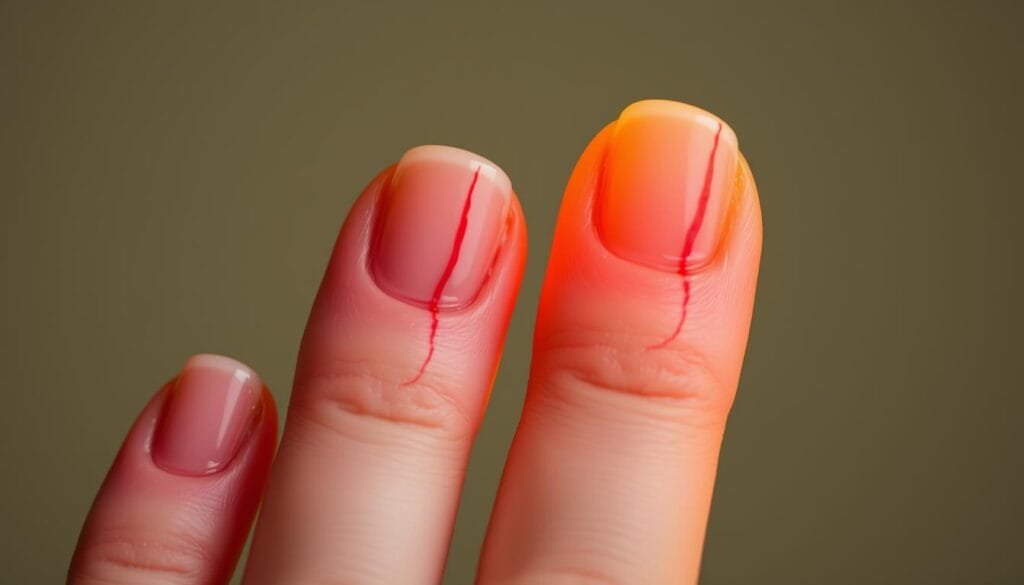Currently Empty: RM0.00
Despite modern food availability, roughly 7% of US adults lack enough vitamin C. This essential nutrient supports immunity, skin health, and tissue repair. Without it, the body struggles to fight infections and heal wounds.
Early signs often go unnoticed—fatigue, slow healing, or easy bruising. Left unchecked, severe deficiency may lead to scurvy, a condition linked to bleeding gums and joint pain. Smokers and heavy drinkers face higher risks due to increased nutrient depletion.
For personalized advice, contact Wellness Concept at +60123822655 (Mon-Fri 9:30am-6:30pm, Sat-Sun 10am-5pm). Their experts help address vitamin deficiencies with tailored solutions.
Key Takeaways
- Vitamin C deficiency affects 7% of adults in the US.
- Early signs include fatigue and slow wound healing.
- Severe cases may progress to scurvy.
- Smoking and alcohol increase deficiency risks.
- Wellness Concept offers expert guidance for nutrient concerns.
1. Introduction to Vitamin C Deficiency
Unlike most animals, humans cannot synthesize vitamin C internally. This water-soluble nutrient, also called ascorbic acid, must come from diet or supplements. Without it, the body struggles to maintain tissues, immunity, and overall health.
Daily needs vary by gender and lifestyle. Men require 90mg, while women need 75mg. Smokers should add 35mg due to increased oxidative stress. Below is a quick reference:
| Group | Daily Requirement (mg) |
|---|---|
| Adult Men | 90 |
| Adult Women | 75 |
| Smokers | +35 |
Despite abundant food options, deficiency persists. Smokers, dialysis patients, and those with eating disorders face higher risks. Even minor shortfalls can disrupt collagen production, weakening skin and joints.
For personalized guidance, Wellness Concept offers consultations, including weekends. Their experts help tailor solutions for optimal nutrient intake.
2. Rough, Bumpy Skin (Keratosis Pilaris)
Rough, bumpy skin often signals deeper nutritional gaps. Known as keratosis pilaris, this condition creates tiny, raised bumps resembling goosebumps—commonly on arms, thighs, or cheeks. About 15% of adults experience these changes, often unaware of their link to nutrient deficiencies.
How Collagen Depletion Affects Skin
Collagen acts like glue for the skin, keeping it smooth and intact. Without enough vitamin C, production falters, causing keratin—a protein—to clog hair follicles. This leads to the “chicken skin” texture many recognize.
Timeframe for Symptom Development
Visible changes take time. After 3-5 months of inadequate intake, bumps may appear. Those with chronically dry skin face a 10% higher risk. A dermatologist can confirm if keratosis pilaris stems from diet or other causes.
3. Corkscrew-Shaped Body Hair
When hair starts curling like corkscrews, a nutrient imbalance may be the cause. These twisted strands often appear brittle, breaking easily with minor friction. Unlike typical split ends, the entire shaft coils tightly, resembling a spring.
Collagen relies on vitamin C to maintain protein bonds. Without it, hair structure weakens, leading to abnormal growth patterns. This condition is a hallmark of prolonged deficiency, often overlooked amid general hair loss.
Key indicators include:
- Increased fragility—strands snap when brushed.
- Visible kinks or bends under a magnifier.
- Slower regrowth in affected areas.
Recovery typically begins within weeks of proper supplementation. Most see normal hair texture return in 4–6 weeks. Early detection helps prevent permanent follicle damage.
Note: Similar symptoms may occur with thyroid disorders. A dermatologist can confirm if diet or other factors affect your body.
4. Bright Red Spots Around Hair Follicles
Tiny red dots near hair roots may signal a deeper issue. These bright red spots, called perifollicular hemorrhages, occur when capillary blood vessels rupture. They resemble pinpricks and often cluster on thighs or arms.
Vitamin C strengthens blood vessel walls. Without it, collagen production drops, making capillaries fragile. Even minor pressure—like tight clothing—can cause leaks.
Key traits differentiate these marks from other skin conditions:
- Size: Smaller than allergy hives (1–2mm).
- Color: Crimson, not purple like bruising.
- Location: Concentrated around hair shafts.
With 300mg daily supplementation, most see improvement in two weeks. Advanced deficiency may prolong healing. If spots persist, consult a dermatologist to rule out clotting disorders.
Note: Smokers and those with poor diets face higher risks. Early symptoms often precede scurvy’s severe effects.
5. Spoon-Shaped Nails with Red Lines
Nail changes often reveal hidden nutrient gaps before other signs appear. About 30% of cases linked to vitamin C deficiency show abnormalities like koilonychia—nails that curve inward, resembling tiny spoons. This occurs when collagen production falters, weakening the nail bed.

Red streaks, called splinter hemorrhages, may also form. These thin blood lines appear when fragile capillaries rupture. Unlike injuries, they don’t grow out with the nail and signal prolonged deficiency.
Collagen, Iron, and Nail Health
Vitamin C aids iron absorption, crucial for nail strength. When both nutrients dip, nails become brittle and pale. Below is a quick comparison:
| Condition | Primary Cause | Key Feature |
|---|---|---|
| Koilonychia | Iron + Vitamin C Deficiency | Concave nails |
| Splinter Hemorrhages | Vitamin C Deficiency | Red streaks |
| Pure Iron Deficiency | Low Iron Alone | Flat, pale nails |
Comprehensive testing helps pinpoint the root cause. Wellness Concept provides weekday assessments to address these symptoms holistically. Their team tailors solutions combining diet tweaks and targeted supplements.
6. Dry, Damaged Skin
Healthy skin relies on a delicate balance of nutrients, with vitamin C playing a starring role. When levels drop, the skin loses moisture, becoming rough and prone to irritation. Studies show a 10% higher risk of wrinkles with prolonged deficiency.
Shielding Against Sun Damage
Vitamin C acts as a natural sunscreen, reducing UV harm by 40%. It neutralizes free radicals that break down collagen, the protein keeping skin firm. Smokers face double damage—nicotine depletes this antioxidant faster.
Fighting Premature Aging
Without enough vitamin C, the skin struggles to repair itself. Fine lines deepen, and elasticity fades.
“Epidermal vitamin C levels drop by 30% in deficient individuals, accelerating photoaging,”
notes a 2022 dermatology study.
To replenish stores, focus on a diet rich in citrus, bell peppers, and leafy greens. For a targeted boost, consider serums or supplements—especially if sun exposure or smoking is a daily reality.
7. Easy Bruising and Fragile Blood Vessels
Unexplained bruises often hint at hidden nutritional gaps. About 60% of chronic bruisers show suboptimal vitamin C levels. This essential nutrient strengthens vessel walls by supporting collagen production.
| Type | Appearance | Cause |
|---|---|---|
| Purpura | Larger purple patches | Deep vessel leaks |
| Petechiae | Pinhead red dots | Surface capillary bursts |
Minor bumps shouldn’t leave dramatic marks. When they do, fragile blood vessels may be the culprit. Vitamin C helps the coagulation system function properly—without it, bruises linger longer.
Severe cases risk internal bleeding. Nosebleeds or gum bleeding alongside bruising warrant immediate attention. Those with persistent symptoms should consult Wellness Concept for deficiency testing.
Quick fixes include citrus fruits and leafy greens. For stubborn bruising, targeted supplements may rebuild collagen stores within weeks.
8. Slow Wound Healing
When wounds take weeks to close, vitamin C levels could be to blame. Chronic ulcer patients show 70% lower levels, delaying recovery by months. Even minor cuts may linger, signaling collagen shortages.
Collagen acts as scaffolding for new tissue. Without it, fibroblasts—cells that rebuild skin—struggle to function. Damaged areas stay inflamed, raising infection risk by 25%.
Key impacts of deficiency:
- Surgical complications: Incisions reopen 3x more often.
- Time delays: Healing takes 40% longer.
- Diabetics face higher odds of chronic ulcers.
Elderly adults and smokers need extra attention. Their bodies absorb fewer nutrients, worsening healing delays. A balanced diet with citrus or supplements can restore repair rates in 4–6 weeks.
“Vitamin C deficiency prolongs inflammatory phases, stalling tissue regeneration,”
notes a 2023 clinical review. For stubborn cases, blood tests help pinpoint gaps.
9. Painful, Swollen Joints
Joint discomfort can sometimes reveal deeper nutritional imbalances. In severe cases, 25% of individuals with prolonged deficiency report stiffness or swelling. Collagen breakdown weakens synovial fluid, the lubricant cushioning bones.
When Bleeding Occurs (Hemarthrosis)
Stage 4 deficiency may cause hemarthrosis—bleeding into joint spaces. Fragile capillaries rupture, leaking blood that pools around knees or elbows. This creates sudden pressure, limiting mobility.
Key differences from arthritis:
- Onset: Faster (days vs. arthritis’ gradual progression).
- Color: Skin appears reddish-purple, not just swollen.
- Response: Improves within 1 week of vitamin C supplementation.
| Condition | Primary Cause | Urgency Level |
|---|---|---|
| Hemarthrosis | Vitamin C Deficiency | High (requires care within 24h) |
| Osteoarthritis | Cartilage Wear | Medium (schedule specialist visit) |
“Intra-articular bleeding is reversible if treated early. Delayed care risks permanent joint damage,”
notes a 2023 rheumatology study. For sudden swelling, seek immediate evaluation to rule out clotting disorders.
Mild cases often resolve with 500mg daily vitamin C. Citrus fruits, strawberries, and supplements help restore collagen. Smokers may need higher doses due to accelerated nutrient loss.
10. Weak Bones and Increased Fracture Risk
Brittle bones may indicate more than just aging—nutrient gaps could be the culprit. Vitamin C fuels osteoblasts, cells that build bones by producing collagen. Without it, bone matrix density drops, raising osteoporosis risk by 30%.
Pediatric cases show severe effects. Scurvy-related bone deformities—like bowed legs—occur when growing skeletons lack collagen support. Even mild deficiency slows mineralization, stunting growth.
| Group | Impact | Prevention |
|---|---|---|
| Adults | 22% higher fracture rates | 500mg daily vitamin C + calcium |
| Children | Growth plate abnormalities | Diet rich in citrus + leafy greens |
Vitamin C boosts calcium absorption by 50%. Together, they strengthen skeletal structure. Silent bone loss often progresses unnoticed until a minor fall causes breaks.
“Low vitamin C levels correlate with thinner femoral neck bones, a key fracture site in elders,”
Smokers and postmenopausal women face higher dangers. Regular screenings help catch deficits early. For personalized plans, consult a nutritionist to balance diet and supplements.
11. Bleeding Gums and Tooth Loss
Oral health issues often reveal deeper nutritional deficiencies. When gums bleed easily or teeth loosen, advanced deficiency may be present. These signs typically appear after 3-6 months of inadequate intake.
Collapse of Periodontal Support
Collagen maintains gum tissue integrity. Without it, the periodontal ligament weakens, causing:
- Spontaneous bleeding from gingival margins
- Characteristic “scurvy gums” – swollen, purple-tinged tissue
- Dentin-enamel separation leading to tooth loss
Chronic halitosis often accompanies these changes. The breath develops a metallic odor from tissue breakdown and bacterial overgrowth.
| Condition | Key Features | Urgency Level |
|---|---|---|
| Scurvy-related | Bleeding + tooth mobility | Emergency care needed |
| Gingivitis | Bleeding only | Schedule dental visit |
| Periodontal disease | Bone loss present | Immediate treatment |
“90% of scurvy cases present with gum bleeding before other systemic symptoms emerge,”
Emergency signs include teeth falling out without trauma or pus discharge. These require same-day dental evaluation. For milder cases, increasing citrus intake often reverses changes within 2-3 weeks.
12. Persistent Fatigue and Poor Immunity
Frequent illnesses often point to hidden nutritional gaps. Immune cells store 100 times more vitamin C than blood, making them vulnerable to depletion. When levels drop, the body struggles to fight infections, doubling pneumonia risk.
How Deficiency Weakens Defenses
Leukocytes—white blood cells—lose potency without enough vitamin C. This impairs cytokine production, proteins that regulate immune responses. Studies show colds last 40% longer in deficient individuals.
| Immune Component | Impact of Deficiency |
|---|---|
| Leukocytes | 50% slower pathogen clearance |
| Cytokines | Reduced inflammation control |
Energy Drain and Recovery
Fatigue stems from disrupted energy metabolism. Vitamin C helps convert food into fuel. Supplementing 500mg daily improves energy within 48 hours.
- Prolonged recovery: Wounds and infections heal slower.
- Chronic tiredness: Even after adequate rest.
“Restoring vitamin C levels reactivates mitochondrial function, reversing fatigue in deficient patients,”
For personalized immune support, Wellness Concept offers weekend consultations. Their experts tailor plans to boost nutrient absorption and overall health.
13. Iron Deficiency Anemia
Fatigue and pale skin may hint at a hidden nutritional struggle involving iron. Vitamin C boosts absorption by 67%, turning ferric iron (hard to absorb) into ferrous iron (easily used). Without it, even iron-rich diets fall short.
- Fatigue from poor oxygen transport.
- Pale skin and gums due to low blood hemoglobin.
- Spoon-shaped nails (koilonychia).
Tea and coffee drinkers face extra hurdles. Tannins bind iron, slashing absorption by 50%. Pairing plant-based iron (like spinach) with citrus reverses this.
| Intervention | Effect |
|---|---|
| Vitamin C + Iron | 67% higher absorption |
| Tea with Meals | 50% less iron absorbed |
Severe cases may need transfusions. Dual supplementation (iron + 500mg vitamin C) speeds recovery. Wellness Concept tailors plans for at-risk groups like vegetarians or heavy tea drinkers.
“Combined deficiency affects 45% of anemia cases—correcting both nutrients is key,”
14. Unexplained Weight Gain
Stubborn weight gain sometimes points to hidden metabolic disruptions. Low vitamin C levels correlate with a 20% higher BMI, particularly belly fat accumulation. This occurs because the nutrient regulates cortisol, a stress hormone that promotes fat storage.
Vitamin C also influences leptin, the hormone controlling hunger signals. Deficiency may cause leptin resistance, making the brain ignore “fullness” cues. A 2021 study found 150mg daily boosted metabolism by 12% in deficient adults.
Key Factors Differentiating Deficiency-Related Weight Gain
| Factor | Deficiency Link | Thyroid Issue |
|---|---|---|
| Water Retention | Common (collagen loss weakens vessels) | Rare |
| Diet Response | Improves with citrus intake | Requires medication |
For persistent changes, a nutritional assessment helps. Wellness Concept offers tailored plans to address metabolic gaps. Their experts identify whether health issues stem from diet, hormones, or both.
“Vitamin C deficiency mimics thyroid dysfunction in 15% of cases—testing both is crucial for accurate diagnosis,”
Simple fixes include adding bell peppers or kiwi to meals. For those with high risk factors like smoking, supplements may restore balance faster.
15. Treatment and Prevention Options
Nutritional strategies play a key role in preventing deficiency complications. Rebuilding collagen stores requires consistent intake of bioavailable sources. Wellness Concept experts recommend combining dietary changes with targeted support for lasting results.

Powerhouse Foods to Replenish Stores
These top sources deliver concentrated nutrition:
- Acerola cherries – 2740% RDI per cup (raw)
- Yellow bell peppers – 380% RDI per medium pepper
- Guava – 280% RDI per fruit (with skin)
Preserve nutrients with smart preparation:
- Steam instead of boiling (retains 90% vs. 70%)
- Store cut fruits in airtight containers
- Consume raw when possible – cooking destroys 30%
Smart Supplementation Guidelines
| Type | Absorption Rate | Best For |
|---|---|---|
| Liposomal | 90% | Quick recovery |
| Buffered | 75% | Sensitive stomachs |
| Natural extracts | 65% | Maintenance |
Never exceed 2000mg daily without medical supervision. For personalized plans, Wellness Concept provides consultations at +60123822655.
Special Considerations for Smokers
Tobacco use demands extra attention:
- Require 35mg above standard daily intake
- Vitamin C neutralizes free radicals from smoke
- Blood levels drop 40% faster than non-smokers
“Smokers need timed-release supplements to maintain stable levels throughout the day,”
Pairing cessation efforts with nutritional support yields best results. Even reducing cigarette count by half helps absorption improve within weeks.
16. Conclusion
Spotting early signs of nutrient gaps can prevent serious complications. Fatigue, slow healing, or bleeding gums often signal a deeper health issue. Left unchecked, these may progress to scurvy.
Thankfully, 95% of cases improve within weeks with proper care. Increasing citrus intake or adding supplements helps rebuild collagen stores. For severe deficiency, combined approaches work best.
A diet rich in bell peppers, strawberries, and leafy greens supports recovery. Those with persistent symptoms should act fast—early intervention avoids long-term damage.
For personalized guidance, contact Wellness Concept at +60123822655 (Mon-Sun). Their experts tailor solutions to restore balance and vitality.
FAQ
How does low vitamin C affect skin health?
A deficiency weakens collagen production, leading to rough, bumpy skin (keratosis pilaris). Over time, skin becomes dry, prone to wrinkles, and loses its ability to repair sun damage.
Can vitamin C deficiency cause hair changes?
Yes. Brittle, corkscrew-shaped hair and bright red spots around follicles are common signs. These occur due to weakened blood vessels and impaired collagen.
Why do nails become spoon-shaped with red lines?
Insufficient vitamin C disrupts nail bed health, causing thin, concave nails. Red streaks indicate fragile capillaries beneath the surface.
How does scurvy impact oral health?
Bleeding gums, loose teeth, and eventual tooth loss happen in advanced cases. Vitamin C is vital for gum tissue strength and wound healing.
Does low vitamin C increase bone fracture risk?
Absolutely. Collagen loss weakens bones, making them porous and prone to breaks. Joint pain and swelling may also occur.
Can fatigue be linked to vitamin C deficiency?
Persistent tiredness often results from poor iron absorption (leading to anemia) and a weakened immune system—both tied to low levels.
What foods help restore vitamin C levels?
Citrus fruits, bell peppers, kiwi, broccoli, and strawberries are excellent sources. Cooking can reduce content, so raw options are best.
When should someone consider supplements?
If dietary intake is insufficient or conditions like smoking increase needs, supplements can help. Always consult a doctor first.
How long until symptoms improve with treatment?
Mild cases may see changes in weeks, but severe deficiencies (like scurvy) take months. Consistency with diet or supplements is key.



